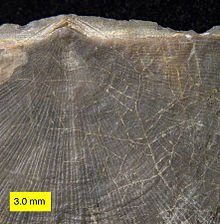
KNOWPIA
WELCOME TO KNOWPIA
Summary
The Ctenostomatida are an order of bryozoans in the class Gymnolaemata. The great majority of ctenostome species are marine, although Paludicella inhabits freshwater. They are distinguished from their close relatives, the cheilostomes, by their lack of a calcified exoskeleton. Instead, the exoskeleton is chitinous, gelatinous, or composed only of a soft membrane, and always lacks an operculum. Colonies of ctenostomes are often composed of elongated, branch-like stolons, although more compact forms also exist.
| Ctenostomatida | |
|---|---|

| |
| Ropalonaria venosa, an etching of an Ordovician ctenostome bryozoan on a strophomenid brachiopod valve.[2] | |
| Scientific classification | |
| Domain: | Eukaryota |
| Kingdom: | Animalia |
| Phylum: | Bryozoa |
| Class: | Gymnolaemata |
| Order: | Ctenostomatida Busk, 1852 |
| Suborders and Superfamilies[1] | |
|
Suborders
Superfamilies
| |
| Synonyms[1] | |
| |
References edit
- ^ a b WoRMS (2021). "Ctenostomatida". WoRMS. World Register of Marine Species. Retrieved 7 April 2021.
- ^ Pohowsky, R.A. (1978). "The boring ctenostomate bryozoa: taxonomy and paleobiology based on cavities in calcareous substrata". Bulletins of American Paleontology. 73: 192p.
Barnes, Robert D. (1982). Invertebrate Zoology. Philadelphia, PA: Holt-Saunders International. p. 910. ISBN 0-03-056747-5.


